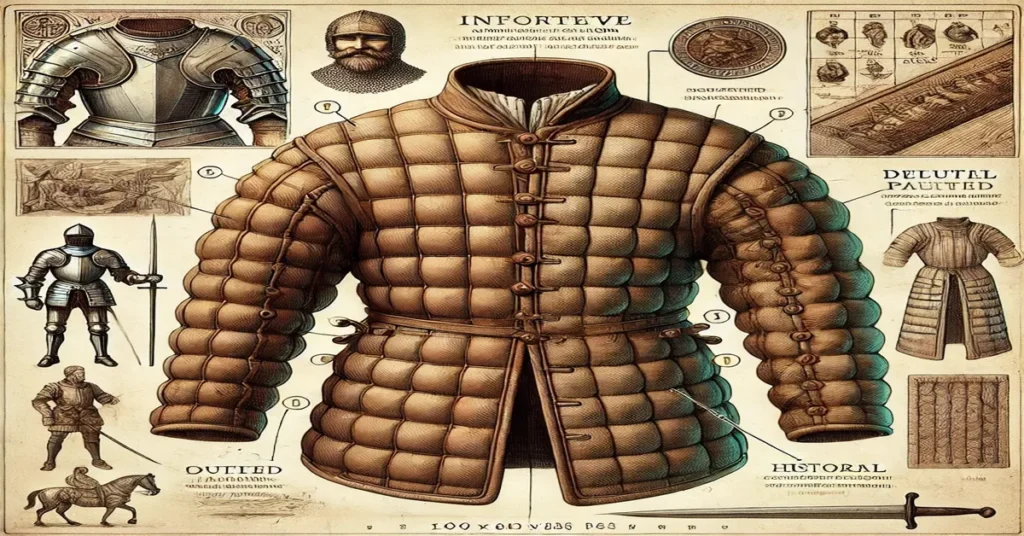The gambeson is a type of padded garment that served as essential armor during the Middle Ages and even into the early Renaissance. Made from layers of fabric, usually linen or wool, stuffed with various materials like wool, horsehair, or cotton, gambesons provided protection and cushioning against blows. This unique piece of armor could be worn on its own or as padding beneath metal armor, making it incredibly versatile. In fact, many modern-day enthusiasts of historical reenactments, martial arts, and even fantasy films still use gambesons due to their practicality, historical authenticity, and comfort.
This article explores the history, construction, types, and contemporary uses of the gambeson. From its origins to its modern-day applications, we’ll dive into the fascinating evolution of this garment and examine why it remains relevant and popular among enthusiasts today. Additionally, we’ll cover the materials and techniques used in creating gambesons, offering a detailed guide for anyone interested in making or purchasing their own.
The Historical Origins of the Gambeson
The term “gambeson” derives from the Old French word gambeson, which means “a quilted garment.” The use of padded clothing for protection dates back to antiquity, with early forms of padded armor found across many ancient cultures, including the Egyptians, Persians, and Greeks. However, the gambeson as it is known today emerged around the 11th century in Europe, evolving from earlier forms of quilted or padded protective garments.
In the Middle Ages, gambesons became a staple of military attire, especially for soldiers and knights. As armies sought to improve protection without compromising mobility, gambesons offered a lightweight, flexible solution that could be worn alone or under plate armor. They were widely used by infantry, archers, and mounted knights alike, making the gambeson one of the most ubiquitous and versatile pieces of medieval armor.
Role in Medieval Warfare
The gambeson was particularly valued because it provided several types of protection. The quilted fabric absorbed and dispersed the force of blunt trauma, such as from clubs or maces, reducing the impact on the wearer’s body. Additionally, the thickness of the garment made it difficult for arrows and blades to penetrate fully, even without metal armor over it. When worn beneath chainmail or plate armor, gambesons provided additional protection by absorbing the shock of blows and preventing chafing from metal.
Because gambesons were relatively inexpensive to produce compared to metal armor, they were widely accessible, even for lower-ranked soldiers. Thus, gambesons became standard issue for soldiers of varying social statuses, not only for knights and nobles.
Construction and Materials of Gambesons
A typical gambeson is made from several layers of fabric sewn together, with padding material in between. The construction methods and materials used can vary widely depending on the intended use and the wearer’s needs. Historically, gambesons were often tailored to the individual, providing a snug fit that allowed for freedom of movement.
Layers and Padding
A gambeson generally consists of three main components:
- Outer Layers: The outermost layer of a gambeson was typically made of durable materials like linen or canvas. Linen was favored for its strength and comfort, while canvas offered more resistance against wear.
- Inner Layers: The inner layers often consisted of softer, more comfortable fabric to prevent chafing against the skin. Wool or cotton were commonly used for this purpose.
- Padding: The padding material varied depending on the availability of resources and the desired level of protection. Wool, cotton, horsehair, and even straw were commonly used as stuffing. The layers were sewn in a quilted pattern, which helped to keep the padding in place and added structural strength.
Quilting Patterns and Stitching
The quilting pattern used in the construction of a gambeson played an important role in its effectiveness. Diamond, herringbone, and straight vertical quilting patterns were popular choices, as they provided stability to the garment and prevented the padding from shifting. Quilting also contributed to the aesthetics of the garment, giving it a distinct, decorative look.
The stitching had to be durable enough to withstand the force of blows without coming undone. Double stitching or using waxed linen thread helped reinforce the seams, ensuring that the gambeson remained intact even during prolonged use.
Types of Gambesons
There were two primary types of gambesons used historically:
- Aketon: Also known as a padded jack, the aketon was a thinner, lighter version of the gambeson, often worn beneath chainmail. Its purpose was mainly to add comfort and reduce chafing rather than provide full protection.
- Doublet: The doublet was a thicker and more heavily padded gambeson, worn as a stand-alone piece of armor or under plate armor. It was particularly popular among infantry and other soldiers who did not have access to more expensive metal armor.
The type of gambeson chosen depended on the wearer’s role on the battlefield and the level of protection required.
The Functionality of Gambesons
Gambesons were valued not only for their protection but also for their versatility. Their design made them ideal for a wide range of combat scenarios, from large-scale battles to close-quarters skirmishes. Here’s how the gambeson functioned across different contexts:
Protection Against Blunt Force
The padding in a gambeson served to absorb and distribute the force of blunt impacts, reducing the risk of fractures and other injuries. This made it an excellent defense against weapons like maces and clubs, which were common in medieval warfare.
Defense Against Cutting and Piercing Weapons
While a gambeson would not stop a sharp blade or piercing weapon as effectively as metal armor, it still offered some resistance. The thickness of the garment made it difficult for an enemy to slice through to the skin, especially if multiple layers of padding were used. Against arrows and other projectiles, the gambeson could reduce the likelihood of serious injury.
Layering with Metal Armor
For those who could afford it, gambesons were often worn beneath chainmail or plate armor, adding an extra layer of protection. The gambeson’s padding acted as a shock absorber, preventing bruising and minimizing the risk of blunt trauma from hits to the metal armor. This layering approach was particularly popular among knights and other high-ranking soldiers.
Gambesons in Modern Culture and Reenactment
Though no longer used in combat, gambesons remain popular today among historical reenactors, HEMA (Historical European Martial Arts) practitioners, and fans of medieval and fantasy culture. In these contexts, gambesons serve both as a practical and aesthetic element.
Historical Reenactment and HEMA
For participants in historical reenactment groups and HEMA practitioners, wearing a gambeson provides an authentic experience of medieval combat. The padded garment allows for safe, realistic sparring while maintaining historical accuracy. Many reenactors wear gambesons under chainmail or plate armor to replicate the full weight and protection that medieval soldiers experienced.
LARP and Fantasy Cosplay
Gambesons have also become a staple in LARP (Live Action Role Playing) and fantasy cosplay communities. With the rise in popularity of fantasy series like Game of Thrones and The Witcher, gambesons have become popular costume pieces for portraying medieval or fantasy warriors. Lightweight versions of gambesons are commonly used in these contexts, allowing for greater comfort while still looking historically accurate.
Film and Television
In film and television, gambesons are often used to give characters an authentic medieval appearance. Costume designers create modified versions of the gambeson for actors, allowing for greater mobility and comfort during filming. Films that portray historical battles or medieval themes often feature gambesons as part of the characters’ armor, adding to the visual authenticity.
How to Choose or Make a Gambeson
For those interested in owning a gambeson, there are two main options: purchasing a ready-made gambeson or making one from scratch. Here are some considerations for each approach.
Buying a Gambeson
When purchasing a gambeson, consider the following factors:
- Material: Look for a gambeson made from quality materials like linen, wool, or heavy cotton. Avoid synthetic fabrics if you are seeking historical accuracy.
- Thickness and Padding: Determine the level of padding you need. For HEMA practice or reenactment, a thicker gambeson will provide better protection.
- Size and Fit: Gambesons should be snug but not restrictive. Check sizing charts and measurements to ensure a good fit.
- Quilting Pattern: Choose a quilting pattern that appeals to you, as this will affect both the appearance and functionality of the garment.
Making a Gambeson
For DIY enthusiasts, making a gambeson can be a rewarding project. Here’s a basic outline:
- Choose Your Materials: Select durable fabric for the outer layers and a suitable padding material, like wool or cotton batting, for the inner layers.
- Cut the Fabric: Cut the fabric pieces according to your measurements, ensuring enough material for sleeves, torso, and any additional padding.
- Layer and Quilt: Lay the fabric pieces and padding layers together, sewing them in a quilted pattern to keep the padding stable.
- Sew the Garment Together: Once quilted, sew the individual pieces together, paying attention to reinforcement at the seams for added durability.
- Add Fastenings: Historically, gambesons used lacing, buttons, or leather ties. Choose a fastening method that suits your preferences and adds to the authenticity of your gambeson.
The Gambeson’s Place in Modern Self-Defense and Safety Gear
While gambesons are no longer used in traditional warfare, the concept of padded armor has influenced modern self-defense and safety gear. Contemporary protective clothing used in sports and law enforcement often incorporates padding similar to that of a gambeson. For example:
- Martial Arts and Combat Sports: Padded jackets used in martial arts, such as kendo and fencing, provide similar protection against blunt force as a gambeson.
- Motorcycle Gear: Motorcycle jackets often have padded inserts to protect against impact, similar to how gambesons were padded to protect against blunt trauma.
- Law Enforcement and Riot Gear: Padded clothing and body armor worn by police officers during riot control share some functional similarities with gambesons, providing shock absorption and protection from blunt impacts.
Conclusion
The gambeson, a medieval garment designed for protection in combat, is an enduring piece of history that has found a place in modern culture. Whether used in historical reenactments, martial arts, or fantasy cosplay, the gambeson serves as a functional and aesthetically pleasing reminder of medieval armor. Its layered construction, durable materials, and versatility make it a valuable piece for anyone interested in historical combat or medieval clothing.
The gambeson’s legacy continues to influence modern protective gear, demonstrating that the principles of medieval armor design remain relevant today. As an artifact of the past and a functional piece for enthusiasts, the gambeson bridges history with the present, allowing individuals to connect with the traditions of medieval warfare in a tangible way.
FAQs
- What is a gambeson made of?
- A gambeson is typically made from layers of fabric such as linen or wool, padded with materials like wool, cotton, or horsehair.
- Is a gambeson effective armor?
- Yes, a gambeson offers protection against blunt force and some resistance to cuts and piercing weapons, especially when worn under metal armor.
- Can you wear a gambeson alone?
- Yes, a gambeson can be worn on its own as armor, particularly by soldiers without access to metal armor, like common infantry.
- How does a gambeson compare to chainmail?
- A gambeson provides padding and shock absorption, whereas chainmail offers protection against cuts. Together, they create a highly effective combination.
- Are gambesons comfortable to wear?
- Properly fitted gambesons can be comfortable, although they can become warm due to the thick padding, especially in summer.
- Where can I buy a gambeson?
- Gambesons are available at medieval reenactment suppliers, online marketplaces, and specialty stores that cater to HEMA, LARP, and historical costume needs.







